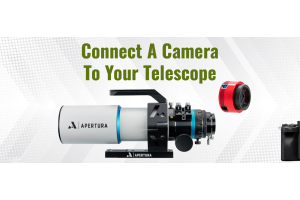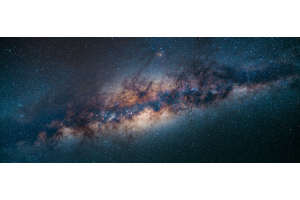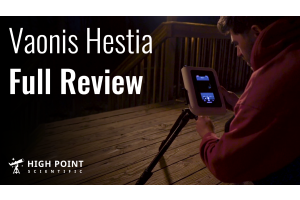
Of the eight planets in our solar system, only five are visible to the naked eye in our night sky: Mercury and Venus, which never stray far from the Sun, and then Mars, Jupiter, and Saturn. The last two planets in our solar system, Uranus and Neptune, are so faint that they were only discovered after the invention of the modern telescope. These two planets can be elusive to find, as they will first appear as nothing more than another star of thousands in our night sky. This guide will go over how to find the planets Uranus and Neptune throughout 2021.
What You’ll Need:
To spot these planets, you’ll be looking for several faint stars that serve as “guide” stars. To be able to do this, you’ll need some sort of map of the night sky. We’d strongly recommend using a smartphone planetarium app, such as SkySafari or Stellarium, as they will be able to identify faint stars in your field of view. Additionally, while most telescopes will be able to spot Uranus and Neptune, to be able to actually resolve the two as anything other than points of light, we recommend a telescope of at least 4” aperture or greater. Some great telescopes include the Explore Scientific 102mm Air Space Doublet Refractor or the Apertura DT6 Dobsonian telescope.
How to Spot Uranus in 2021
Uranus, the seventh planet from the Sun, will be at its best towards the second half of the year. Opposition with Uranus, or the point where Uranus will be at its best and brightest in terms of its positioning with the Earth, occurs on November 4th. Uranus will spend the year wandering westwards from the constellation of Cetus (also known as the whale in Greek mythology).
You’ll be identifying Uranus through a process called “star-hopping”, or literally moving from one star to the next until you (roughly) land on your target. Once you’ve identified the major stars of Cetus, look for the asterism that makes up the head of the whale. These stars are: Menkar, Kaffaljidhma, 78 Cet, Al Kaff al Jidhmah II, Al Kaff al Jidhmah IV, and Menkab. Depending on how dark your sky is, you might only be able to spot one or two of these stars with the naked eye, such as Menkar, and binoculars may be needed. Once you find the head of Cetus, look for the star Al Kaff al Jidhmah IV (also known as Mu Ceti). Mu Ceti will be your guide star to Uranus.
Image: Simulated view of the night sky on the evening of November 4th courtesy of Stellarium. Cetus can be spotted near Taurus the Bull, rising in the east. Click image for full size.
Once you’ve centered Mu Ceti in your eyepiece or binoculars, move to the northeast until you find the star 38 Ari. 38 Ari is a faint, 5th magnitude star that is barely visible to the naked eye in the constellation of Aries. From 38 Ari, continue moving to the northeast until you land on Omicron Arietis (o Arietis). Uranus will spend most of the year in the vicinity of this star, although later in the year it’ll drift slightly west towards the double star 29 Ari. Uranus will appear as a pale-blue star near Omicron Arietis. Double-check that you’ve found Uranus by centering it in your low-power eyepiece and putting in an eyepiece with a higher magnification. You should resolve Uranus as a very tiny disk instead of a point of light.
Image: The head of Cetus the Whale, with Mu Ceti highlighted. Uranus will be off to the northeast of this star on the eastern horizon throughout the year. Click image for full size.
Uranus will spend most of the year in the vicinity of this star, although later in the year it’ll drift slightly west towards the double star 29 Ari. Uranus will appear as a pale-blue star near Omicron Arietis. Double-check that you’ve found Uranus by centering it in your low-power eyepiece and putting in an eyepiece with a higher magnification. You should resolve Uranus as a very tiny disk instead of a point of light.
Image: This is where Uranus will appear on the night of opposition; its actual position when you observe it will vary throughout the year, but will be relatively near these stars. Click image for full size.
How to Spot Neptune in 2021
Neptune, the last planet in the solar system, is a significantly trickier target to be able to spot in 2021. There are very few bright stars near Neptune, so relying on faint guide stars will be the only way to find it. Neptune will be at its best in the second half of summer in 2021, with opposition occurring on September 14th. Neptune will be visible between the constellations of Aquarius and Pisces. To find Neptune, turn to your planetarium app and focus on the constellation of Aquarius. In the constellation of Aquarius, find the star Psi1 Aquarii (also known as 91 Aquarii) - a 4th magnitude triple star that will serve as your guide star.
From Psi1 Aquarii, move your telescope or binoculars to the stars Chi Aquarii and Phii Aquarii. These stars are roughly the same magnitude as Psi Aquarii and will help you point to Neptune. Once you find Phi Aquarii, move the telescope slightly north until you find 96 Aquarii, a faint magnitude 5 star that might be difficult to identify.
Click image for full size.
Unfortunately, there are no stars brighter than 6th magnitude near Neptune this year. As mentioned, Neptune is poorly positioned this year as it is farther away from the brighter stars in Aquarius than in previous years. As such, you will likely have to make several tries to find it. Neptune will appear as a faint, deep-blue star. Like with Uranus, try increasing the magnification with a high power eyepiece and Neptune should appear as a disk.
Click image for full size.
Other Tips & Tricks
As mentioned above, the best way to spot Uranus and Neptune is through eyepieces that’ll yield a low magnification. Even better would be a pair of binoculars, such as the Celestron SkyMaster 25x70, which should be sufficient to spot the guide stars to point your way towards these two planets. Although star-hopping can be a rewarding way to become more familiar with the stars in the night sky, you might prefer to simply use a computerized tracking mount that’ll easily be able to find either of these planets in the sky, provided your mount is aligned correctly. However, once you are familiar with star-hopping and your skill at locating these two faint planets increases, you might find that you’re able to locate Uranus and Neptune faster than even a computerized telescope.

Questions? Contact Us!
Still struggling to spot Neptune or Uranus? Not sure which telescope or pair of binoculars is right for you? Send a message to our non-commissioned gear experts! Our team are happy to point you in the right direction.
This Article was Last Updated on 08/16/2023

















